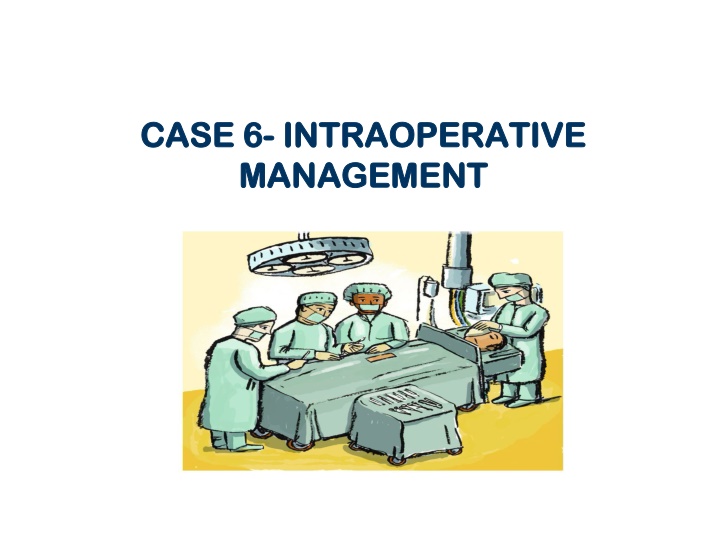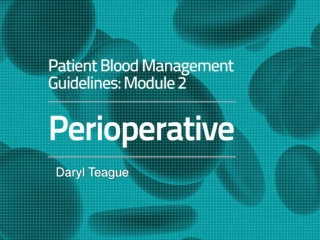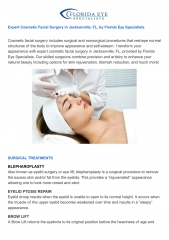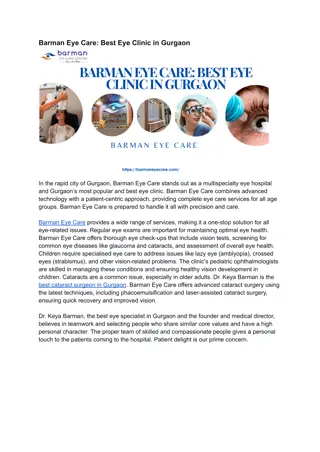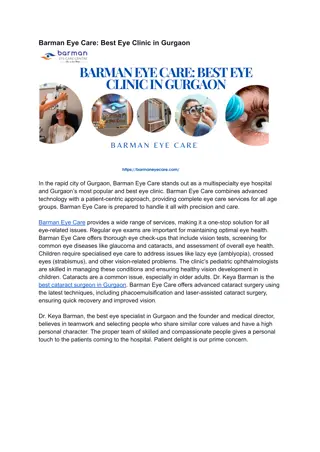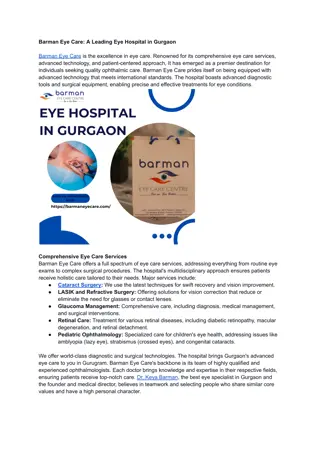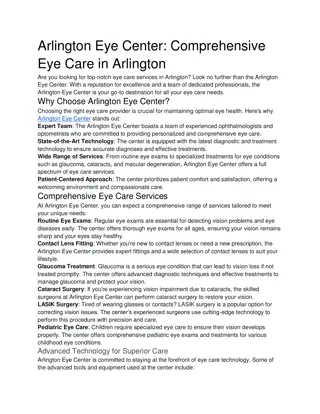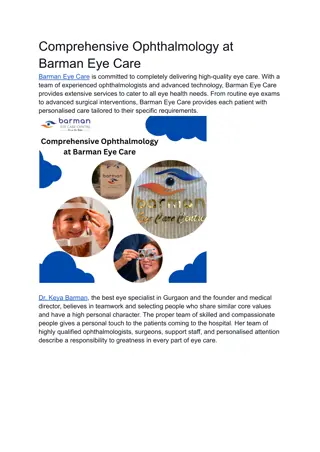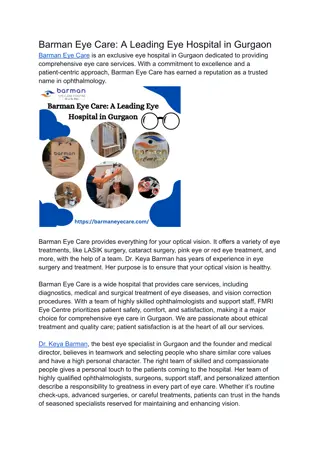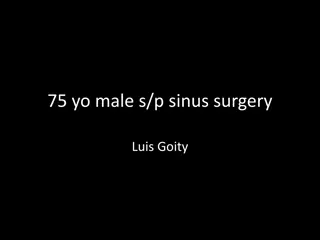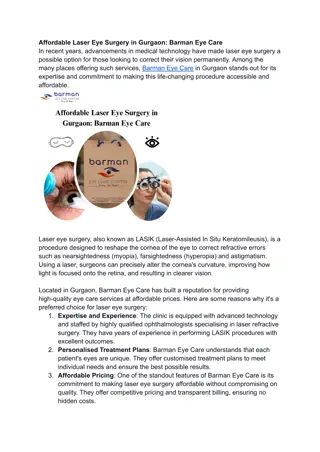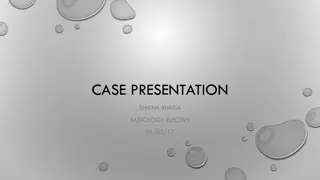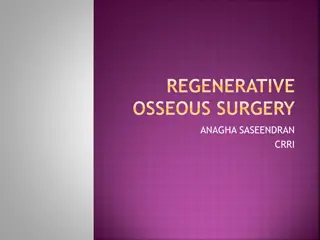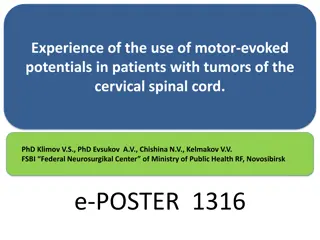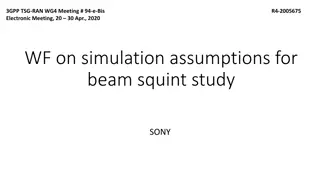Intraoperative Management of 4-Year-Old Male Patient for Eye Squint Surgery
Assessing a 4-year-old boy scheduled for eye squint surgery involves evaluating family history, dentition, airway considerations, and preoperative tests. Factors like obesity, OSA, previous illnesses, and medications play a crucial role in determining perioperative risk. Maintaining communication with the child and family, conducting thorough examinations, and considering airway assessments are essential steps in preoperative evaluation.
Download Presentation

Please find below an Image/Link to download the presentation.
The content on the website is provided AS IS for your information and personal use only. It may not be sold, licensed, or shared on other websites without obtaining consent from the author.If you encounter any issues during the download, it is possible that the publisher has removed the file from their server.
You are allowed to download the files provided on this website for personal or commercial use, subject to the condition that they are used lawfully. All files are the property of their respective owners.
The content on the website is provided AS IS for your information and personal use only. It may not be sold, licensed, or shared on other websites without obtaining consent from the author.
E N D
Presentation Transcript
CASE 6 CASE 6- - INTRAOPERATIVE INTRAOPERATIVE MANAGEMENT MANAGEMENT
A 4- YEARS OLD MALE PATIENT BOOKED FOR RIGHT EYE SQUINT SURGERY HOW YOU WILL ASSESS THIS PATIENT HOW YOU WILL ASSESS THIS PATIENT PREOPERATIVELY. PREOPERATIVELY.
Previous Family History Illnesses Malignant Hyperthermia History and examination Dentition Pre- existing Damage, Risk of Damage Medication and Allergies Rapport should be established with the child and his/her parent(s) Past Weight and Anaesthetic Age History
Previous Small mouth Cervical difficulties spine with airway problems management Obesity- Airway obstructive Protruding/ 'buck' teet sleep apnoea Assessment (OSA) surgery/Radiot Conditions herapy to affecting Infection to head and tongue size the airway neck URTI common in young children and place the child at increased risk of perioperative respiratory problems. Ideally, several weeks should have elapsed following a URTI. Child with a productive cough, chest signs or a temperature should not be submitted to elective surgery
Atlanto- occipital Interincisor gap 4 6 cm mobility Sternomental Airway Mallampati score distance Assessment >12.5 cm Thyromental distance >6 cm Mandibular protrusion
Preoperative tests : A.Common tests include full blood count, electrolytes and urea, coagulation screen, ECG and chest X ray. B.For patients at risk and/or those undergoing major surgery (particularly vascular surgery) further, more detailed tests might include: liver function tests; arterial blood gas analysis; respiratory function tests; cardiac echocardiography and other imaging (including angiography) to assess left ventricular function, valve gradients and quantify ischaemic heart disease. C.cervical spine X ray may be required in those with suspected cervical spine degeneration, surgery and trauma as neck mobility is a key determinant of ease of tracheal intubation.
Perioperative medication : Generally, all medication is continued perioperatively except: drugs that affect coagulation (warfarin, heparin, aspirin, clopidogrel); hypoglycaemics; some hypotensive drugs, e.g.ACE inhibitors are stopped only on the day of surgery. Assessment of risk : There are many general risk-scoring systems; the most well known is the American Society of Anesthesiologists (ASA) grading
DISCUSS FASTING TIME AND DISCUSS FASTING TIME AND PREMEDICATION PREMEDICATION
Fasting To prevent aspiration elective surgery should not proceed unless the patient has had: >2 hours since last clear fluid >4 hours since milk >6 hours since last solid food. Premedication: The 6 As of premedication Anxiolysis Amnesia E.g. lorazepam Anti-emetic E.g. benzodiazepines e.g. dopamine antagonists Antacid Anti-autonomic Preoperative drying of secretions Analgesic E.g. Oral sodium citrate
The patient seen in preoperative anesthesia clinic and cleared for squint surgery under general anesthesia, bwt: 16 kg WHAT ARE THE PHYSIOLOGICAL WHAT ARE THE PHYSIOLOGICAL DIFFERENCE BETWEEN ADULT AND DIFFERENCE BETWEEN ADULT AND PEDIATRIC PATIENT PEDIATRIC PATIENT
Body water: The increased metabolic rate characteristic of neonates results in accelerated turn overs of ECF and dictates meticulous attention to intraoperative fluid replacement. Thermoregulation: The infant is especially vulnerable to hypothermia because of both the large ratio of body surface area to weight and a limited ability to cope with cold stress This problem is compounded by cold operating rooms, wound exposure, intra venous fluid administration, dry anesthetic gases and the direct effect of anesthetic agents on temperature regulation. Heat lost by conduction is reduced by placing the baby on a warm mattress and warming the operating room.
Respiratory system:system: Respiratory system:system: Oxygen consumption of neonates is more than 6 ml/kg which is about twice that of adults on a weight basis. To satisfy this high demand alveolar ventilation is doubled compared with that in adults. Because the tidal volume on a weight basis is similar for infants and adults, the increased alveolar ventilation is accomplished by an increased breathing rate Cadiac system: Care must be directed to keep the infant warm, maintaining normal arterial oxygen and carbon dioxide tension and minimizing anesthetic induced myocardial depression Renal: the ability to handle free water and soluble loads may be impaired in neonates and the half-life of medications excreted by means of glomerular filtration will be prolonged
DISCUSS ANESTHESIA CONSIDERATION AND DISCUSS ANESTHESIA CONSIDERATION AND SPECIAL CONCERN FOR SUCH THIS SPECIAL CONCERN FOR SUCH THIS SURGERY SURGERY
The airway is covered by drapes and needs to be secured by LMA or in small children ( 2 yo ) a tracheal tube is often preferred The oculocardiac reflex: pressure/ tension on the globe or eye muscles can cause a marked bradycardia : pretreatment with atropine for prevention Postoperative N/V : pretreatment with antiemetic for prevention Postoperative malignant hyperthermia : suxamethonium is best avoided as this is a trigger for MH
DISCUSS DISCUSS ANESTHESIA PLAN , INDUCTION, ANESTHESIA PLAN , INDUCTION, MEDICATIONS METHODS FOR SECURING MEDICATIONS METHODS FOR SECURING THE AIRWAY , MAINTENANCE OF THE AIRWAY , MAINTENANCE OF ANESTHESIA AND INTRAVENOUS FLUID ANESTHESIA AND INTRAVENOUS FLUID REQUIREMENT REQUIREMENT. .
Anesthesia plan A plan of anesthesia should be discussed with parents includes the method of induction, postoperative analgesia and what to expect in term of i.v cannulae , infusions , nasogastric tube, etc Induction Anesthesia can be induced intravenously or by inhalation. IV access may be challenging, as the veins may be small, poorly visible due to subcutaneous fat and painful even with topical anesthesia. Inhalation requires the ability to minimize entrainment of air and allow high concentration of anesthetic to reach alveoli. The medication Paracetamol: is often given in the word followed by regular postoperative doses. NSAIDS: Diclofenac per rectum. Opioids: can be intravenously administrated as PCA or NCA. Local anesthesia: administrated into the wound or via nerve blocks.
Method for securing airway: Face mask : this is the most fundamental skill and should be familiar to all who deal with unconscious patient. A number of adjuncts can be used including chain lift , jaw thrust , guedel airway or nasal airway. Laryngeal mask airway (LMA) : easy to insert , safe and reliable airway for spontaneous ventilation and short episodes of intermittent IPPV Tracheal tube: allowing full protection and IPPV maintenance of anesthesia Maintenance of anesthesia in older children by spontaneously breathing techniques and short procedures. IV fluid requirement Most would give 0.9% saline or hartmann solution. For resuscitation of children up to 20% ml\kg of colloid may be used as a bolus. Glucose containing solution are not usually used except in babies and those with hypoglycemia
During surgery the patient developed During surgery the patient developed sever bradycardia sever bradycardia , discuss the cause and , discuss the cause and treatment treatment
Cause: The oculocardiac reflex: pressure/tension on the globe or eye muscles can cause a marked bradycardia. Treatment: avoided by pretreatment with atropine Afferent Limb Trigeminal Nerve (ciliary ganglion to ophthalmic division of trigeminal nerve to gasserian ganglion to the main trigeminal sensory nucleus). Also afferent tracts from maxillary and mandibular divisions of trigeminal nerve have been documented. Efferent Limb Vagus Nerve (afferents synapse with visceral motor nucleus of vagus nerve located in the reticular formation and efferents travel to the heart and decrease output from the sinoatrial node). Triggering Stimuli Triggered by traction on the extraocular muscles (especially medial rectus), direct pressure on the globe, ocular manipulation, ocular pain.
The surgery lasted 2 hrs and the patient was The surgery lasted 2 hrs and the patient was excubated excubated and shifted to recovery room, What and shifted to recovery room, What is your postoperative analgesia plan is your postoperative analgesia plan
Postoperative Postoperative analgesia analgesia Although squint surgery is one of the most painful ophthalmic procedures, intraoperative opioids should be avoided. They undoubtedly increase the incidence of vomiting and are usually unnecessary for adequate analgesia, which can usually be achieved satisfactorily using: paracetamol and a non-steroidal anti-inflammatory analgesic, e.g. diclofenac, ibuprofen. Peribulbar block is effective in producing good analgesia, as well as reducing the incidence of the oculocardiac reflex. However, most paediatric anaesthetists remain cautious about utilizing this technique in children because of the risks of globe perforation and retrobulbar haemorrhage. Pain relief can be enhanced significantly if a sub-Tenon block is administered at the end of the procedure. Alternatively, satisfactory postoperative analgesia following squint surgery can be obtained using either diclofenac 0.1% or oxybuprocaine 0.4% eye drops alone. If these are administered selectively to the operative site by the surgeon prior to suturing the conjunctiva, the problems associated with an anaesthetic cornea can be minimized.
